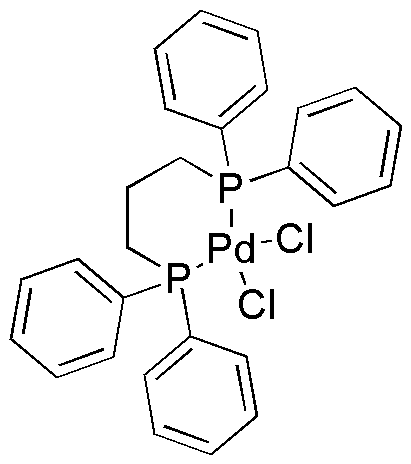(1,3-Bis(diphenylphosphino)propane)palladium(II) chloride Dichloromethane Adduct is widely utilized in research focused on:
- Catalysis: This compound serves as an effective catalyst in various organic reactions, particularly in cross-coupling reactions like Suzuki and Heck reactions, enabling efficient formation of carbon-carbon bonds.
- Pharmaceutical Development: In drug synthesis, it facilitates the creation of complex molecules, streamlining the development of new pharmaceuticals with improved efficacy and reduced side effects.
- Material Science: It is employed in the synthesis of advanced materials, such as polymers and nanomaterials, enhancing properties like conductivity and strength for applications in electronics and coatings.
- Environmental Chemistry: The compound is used in the development of green chemistry processes, reducing waste and energy consumption in chemical manufacturing, which is crucial for sustainable practices.
- Research and Academia: It is a valuable tool in academic research for studying reaction mechanisms and developing new synthetic methodologies, aiding scientists in advancing chemical knowledge and innovation.
General Information
Properties
Safety and Regulations
Applications
(1,3-Bis(diphenylphosphino)propane)palladium(II) chloride Dichloromethane Adduct is widely utilized in research focused on:
- Catalysis: This compound serves as an effective catalyst in various organic reactions, particularly in cross-coupling reactions like Suzuki and Heck reactions, enabling efficient formation of carbon-carbon bonds.
- Pharmaceutical Development: In drug synthesis, it facilitates the creation of complex molecules, streamlining the development of new pharmaceuticals with improved efficacy and reduced side effects.
- Material Science: It is employed in the synthesis of advanced materials, such as polymers and nanomaterials, enhancing properties like conductivity and strength for applications in electronics and coatings.
- Environmental Chemistry: The compound is used in the development of green chemistry processes, reducing waste and energy consumption in chemical manufacturing, which is crucial for sustainable practices.
- Research and Academia: It is a valuable tool in academic research for studying reaction mechanisms and developing new synthetic methodologies, aiding scientists in advancing chemical knowledge and innovation.
Documents
Safety Data Sheets (SDS)
The SDS provides comprehensive safety information on handling, storage, and disposal of the product.
Product Specification (PS)
The PS provides a comprehensive breakdown of the product’s properties, including chemical composition, physical state, purity, and storage requirements. It also details acceptable quality ranges and the product's intended applications.
Certificates of Analysis (COA)
Search for Certificates of Analysis (COA) by entering the products Lot Number. Lot and Batch Numbers can be found on a product’s label following the words ‘Lot’ or ‘Batch’.
*Catalog Number
*Lot Number
Certificates Of Origin (COO)
This COO confirms the country where the product was manufactured, and also details the materials and components used in it and whether it is derived from natural, synthetic, or other specific sources. This certificate may be required for customs, trade, and regulatory compliance.
*Catalog Number
*Lot Number
Safety Data Sheets (SDS)
The SDS provides comprehensive safety information on handling, storage, and disposal of the product.
DownloadProduct Specification (PS)
The PS provides a comprehensive breakdown of the product’s properties, including chemical composition, physical state, purity, and storage requirements. It also details acceptable quality ranges and the product's intended applications.
DownloadCertificates of Analysis (COA)
Search for Certificates of Analysis (COA) by entering the products Lot Number. Lot and Batch Numbers can be found on a product’s label following the words ‘Lot’ or ‘Batch’.
*Catalog Number
*Lot Number
Certificates Of Origin (COO)
This COO confirms the country where the product was manufactured, and also details the materials and components used in it and whether it is derived from natural, synthetic, or other specific sources. This certificate may be required for customs, trade, and regulatory compliance.


